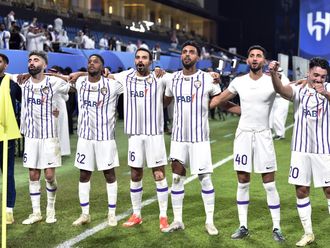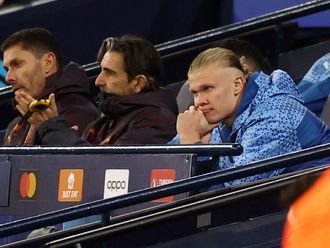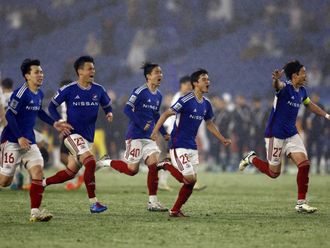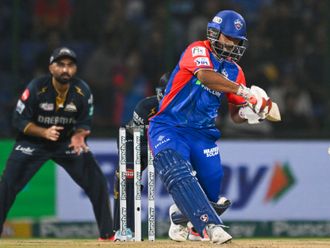Rome: For Italian football fans, merely mentioning the word “scudetto” — league title — is considered taboo.
The theory goes that it’s better left unsaid until your team actually raises the trophy.
Yet recently, the word has begun popping up in animated discussions inside Rome’s myriad coffee bars and on the city’s impassioned sports-talk radio stations.
The talk — and not only in the capital — is that Roma can put together a serious challenge for the Serie A title this season.
For a club that has won only three “scudetti” in its history — the last coming in 2001 — that’s noteworthy.
It’s even more notable considering that it’s only been three years since an ambitious group of four Boston executives took over the club to become the first foreign majority owners of a top-flight Italian team.
“Enthusiasm is a fantastic phenomenon. But it’s a delicate one,” Roma CEO Italo Zanzi told The Associated Press in an interview this week.
The euphoria couldn’t be further from the situation a year ago, when Roma had one of its most tumultuous offseasons in recent memory.
A sixth-place finish in 2013 left Roma out of European competition and then a loss to city rival Lazio in the Italian Cup final resulted in violent protests from fans.
Yet Roma was able to quickly turn things around by bringing in a new coach, the Frenchman Rudi Garcia, and a host of new players that resulted in the team setting a league record by winning its opening 10 matches last season.
Roma went on to finish with a club-record 85 points and placed second behind Turin power Juventus, which set a league-wide record with 102 points — becoming the first squad to break the 100-point barrier.
“We’re thrilled that people are rightfully excited about our potential,” Zanzi said inside his office at the club’s training complex. “But it’s almost inverse to what we had a year ago, where it was very hard to pick people up and get them excited. Now we’re very happy they’re excited but in many ways we have to work to make sure that people realise the season hasn’t even started yet.”
Roma opens the Italian league against Fiorentina on Saturday and have also qualified to compete in the lucrative Champions League this season for the first time since the American takeover.
On Thursday, Roma were drawn into arguably the Champions League’s toughest group, with Bayern Munich, Manchester City and CSKA Moscow.
“I don’t think we were unlucky,” said James Pallotta, a hedge-fund manager and minority owner of the Boston Celtics who is Roma’s president and majority owner. “In the Champions League you have to play against and beat the best teams.”
While Pallotta jets back and forth from the United States to check in on the club and attend big matches, Zanzi — who is from New York — runs the squad on a day-to-day basis.
But most of the club’s staff remains Italian.
“We’re always very careful not to present this as an American product,” Zanzi said. “This is about an institution and a team that has a long and unique history. ... We want to make sure that we do everything possible to honuor the tradition and to be successful but we will follow whatever course we feel gives us the best opportunity to succeed.”
One part of that business model has been to scout and purchase players with big but yet-unrealised potential at low cost and then sell them at great gains a year or two later.
Just this week, Roma sold Morocco defender Mehdi Benatia to German champion Bayern Munich for nearly $35 million (Dh128.5 million), having purchased him for half that price a year earlier from Udinese. Greece defender Kostas Manolas — who stood out during the World Cup — was brought in as a replacement on a $17-million transfer from Olympiakos.
Last year, Brazilian defender Marquinhos was sold to big-spending Paris Saint-Germain for a whopping $46 million, one season after Roma bought him from Brazilian club Corinthians for $6 million.
Roma also gained significantly when it sold promising Argentinian forward Erik Lamela to Tottenham last year.
“We’ve made very strategic investments,” Zanzi said, deferring the credit in that area to sporting director Walter Sabatini.
This off-season, Roma has also been the biggest-spending club in Italy — highlighted by the $30-million purchase of Argentinian winger Juan Manuel Iturbe, a 21-year-old who is already drawing comparisons to Argentina great Lionel Messi.
Yet the squad still revolves around 37-year-old captain Francesco Totti, who is entering his 23rd season with his hometown club.
Pallotta is hoping that Totti will still be playing when the club plans to open a new 52,500-seat stadium, with a design inspired by the Colosseum, for the 2016-17 season.
“I’m even open to carrying Totti in on my shoulders,” Pallotta said recently when Rome Mayor Ignazio Marino flew to New York to discuss the ambitious stadium plan.
Building costs for the stadium on Rome’s outskirts are estimated at $400 million but the overall price, including surrounding infrastructure and transport, will run beyond $1.3 billion.
Roma introduced the stadium project in an elaborate presentation at Rome’s city hall in March. While approval from city and regional authorities has been a complicated process and no ground has been broken yet, Zanzi said opening in two years “is still the timeline.”
In the meantime, though, there is a “scudetto” to chase.










